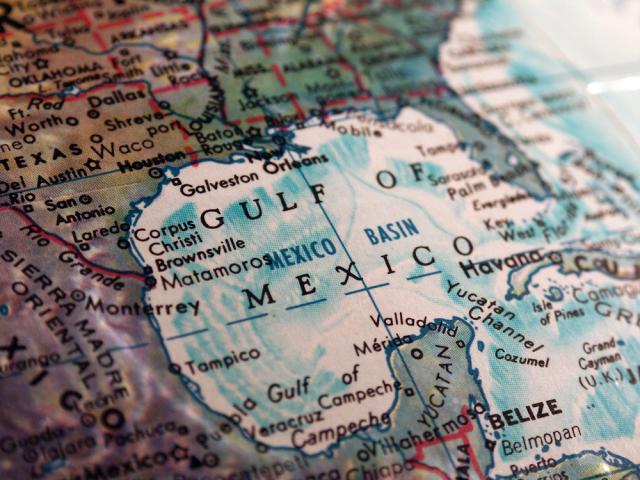
The U.S. Energy Information Administration forecasts Gulf of Mexico oil production will reach 2.11 million barrels per day in 2020. (Source: Shutterstock)
About two months after closing its acquisition of LLOG Exploration Co. LLC’s deepwater Gulf of Mexico (GoM) assets, Murphy Oil Corp. has given the green light to another project offshore the U.S.
The U.S.-based company said Aug. 8 it has sanctioned the King’s Quay floating production system (FPS) facility as it also moves forward with developing the recently sanctioned Samurai project and the adjacent Khaleesi/Mormont development it acquired from LLOG.
“Murphy’s sanction of the trio of projects including the King’s Quay facility, Khaleesi/Mormont and Samurai shows that the Gulf of Mexico still offers attractive investment opportunities,” Wood Mackenzie analyst Mfon Usoro said in a statement. “The Gulf of Mexico has evolved since the downturn to shorter cycle projects and a leaner development approach which has led to lower breakevens and higher returns.”
The move comes as operators step up investment offshore while working toward long-term production growth. It also comes amid industry talk of a slowdown in U.S. shale growth, including in the Permian Basin, on anticipated lower commodity prices.
The seven-well Khaleesi/Mormont and four-well Samurai subsea field developments will each be tied to King’s Quay.
Gross resources for Khaleesi/Mormont are estimated at 165 million barrels of oil equivalent (MMboe), with Samurai’s at about 60 MMboe plus 15 MMboe of potential update—each 90% oil.
“We expect [Khaleesi/Mormont] will produce for the next 20 years generating a full-cycle rate of return of more than 30%,” Murphy Oil CEO Roger W. Jenkins told analysts on a call Aug. 8. He added Murphy plans to invest $200 million over four years on the development.
Work will begin in second-half 2019 on the Samurai development, located less than 10 miles from Khaleesi/Mormont, he said.
“Proximity to the now Murphy owned- and operated-facility not only enhances economics but increases recovered resources net to Murphy,” Jenkins said on the call. “We expect several decades of production from this development as well as a project full-cycle rate of return of over 35%.”
Jenkins added that the FPS could be monetized as the company is looking at selling down a portion of what he said is “highly sought-after” in the midstream asset market. Options are being evaluated.
The FPS is designed to process up to 80,000 barrels of oil per day.
First production from the FPS, which is being constructed in South Korea, and the two field developments are expected in mid-2022 with initial production at more than 30,000 boe/d net.
Wood Mackenzie valued the Khaleesi/Mormont and Samurai developments at more than US$2 billion with each having a development-cycle breakeven below US$35/bbl Brent.
“The FID [final investment decision] of the King’s Quay facility is particularly significant because it is one of only three greenfield projects in deepwater Gulf of Mexico that have achieved FID since the downturn,” said Usoro. “With a new platform set to enter the Gulf of Mexico, it offers up opportunities to commercialize more small-scale subsea tie-backs with higher returns.”
Murphy Oil produced 65,000 boe/d from its offshore business, including offshore Canada, during second-quarter 2019.
Production from the GoM averaged 58,000 boe/d, of which 90% was liquids. The average included a month of production—about 8,800 boe/d produced—from the acquired LLOG GoM assets. Murphy closed the deal in June for net cash consideration of $1.2 billion, after closing adjustments, during the second quarter, making it the region’s fifth-largest producer.
The company said its GoM production from new assets exceeded guidance by 1,200 boe/d, while output from legacy assets exceeded guidance by 1,600 boe/d.
The U.S. Energy Information Administration forecasts GoM oil production will reach 2.11 million barrels (MMbbl) per day in 2020, up from 1.89 MMbbl expected this year.
Recommended Reading
Seadrill Awarded $97.5 Million in Drillship Contracts
2024-01-30 - Seadrill will also resume management services for its West Auriga drillship earlier than anticipated.
Oceaneering Won $200MM in Manufactured Products Contracts in Q4 2023
2024-02-05 - The revenues from Oceaneering International’s manufactured products contracts range in value from less than $10 million to greater than $100 million.
E&P Highlights: Feb. 5, 2024
2024-02-05 - Here’s a roundup of the latest E&P headlines, including an update on Enauta’s Atlanta Phase 1 project.
CNOOC’s Suizhong 36-1/Luda 5-2 Starts Production Offshore China
2024-02-05 - CNOOC plans 118 development wells in the shallow water project in the Bohai Sea — the largest secondary development and adjustment project offshore China.
TotalEnergies Starts Production at Akpo West Offshore Nigeria
2024-02-07 - Subsea tieback expected to add 14,000 bbl/d of condensate by mid-year, and up to 4 MMcm/d of gas by 2028.






